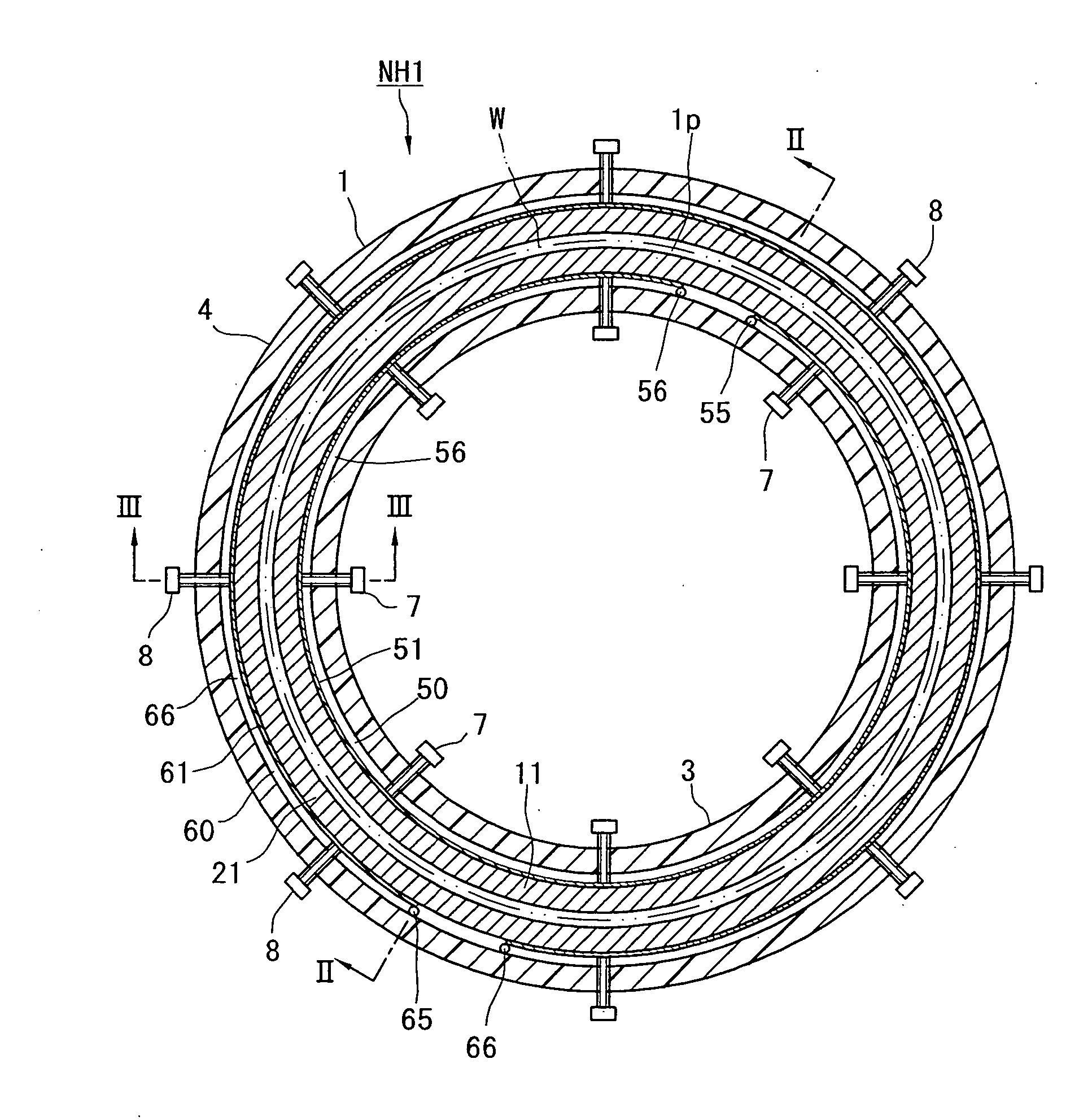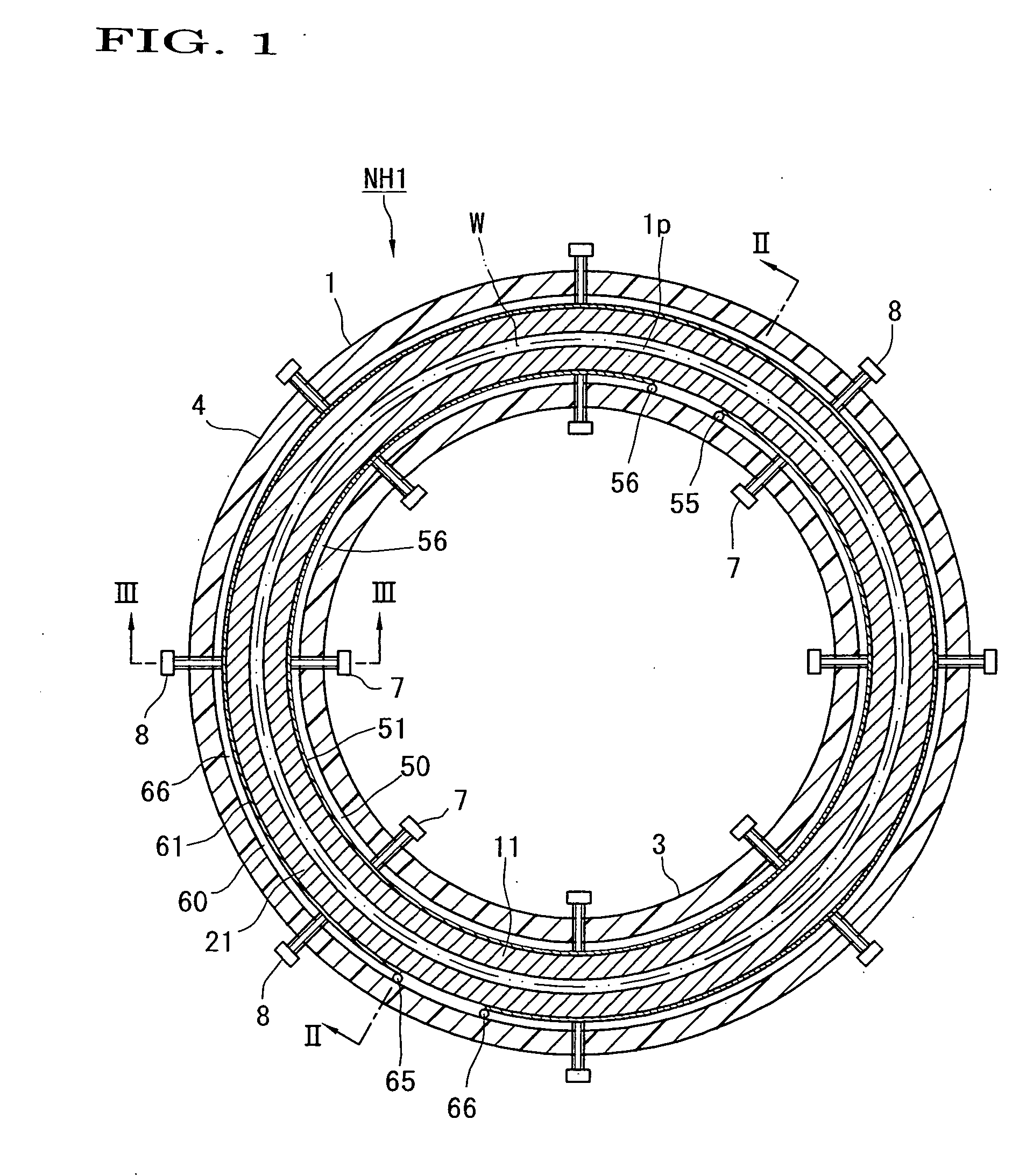Plasma processing apparatus and method
a processing apparatus and technology of plasma, applied in the field of plasma processing apparatus, can solve the problems of reducing the yield of products, physical polishing, and contaminating the outer edge of the wafer, so as to prevent contamination and improve production yield, the effect of easy assembly
- Summary
- Abstract
- Description
- Claims
- Application Information
AI Technical Summary
Benefits of technology
Problems solved by technology
Method used
Image
Examples
first embodiment
[0097] The first embodiment will be described. FIGS. 1 and 2 show a normal pressure plasma etching apparatus M1 (plasma processing apparatus) in which a semiconductor wafer W is used as an object to be processed. The wafer W will be described first. As shown in FIGS. 1 and 2, the wafer W is formed in a disc-like configuration by semiconductor such as silicon. On an upper surface or outer surface of the wafer W, a film 9 such as a photoresist is formed, for example, by spin coater. This film 9 covers the entirety of the upper surface of the wafer W and extends up to the outer edge, i.e., the outer edge part of the upper surface and the outer end face. Should this film 9b occupying the outer edge (imaginary line of FIG. 2) be allowed to remain, it could be an interference in the succeeding polishing process or it could be a cause for generating particles in the process for holding the outer edge. Thus, the wafer W is sent to the normal pressure plasma etching apparatus M1 after it is ...
second embodiment
[0145] As shown in FIGS. 5 and 6, in the second embodiment, plasma etching of a film 9b formed on the outer edge of a semiconductor wafer W is carried out by a normal pressure plasma etching apparatus. The normal pressure plasma etching apparatus M2 comprises an annular nozzle head NH2 in a plan view, a pulse power supply 100 (electric field imparting means), a processing gas supply 70, a suction pump 80 (suction device), and a coolant supply 90 (temperature adjusting medium supply). The nozzle head NH2 comprises an inner electrode structure 10, an outer electrode structure 20, an insulating holder 30 for covering those electrode structures 10, 20, and a metal-made (conductive) frame 40 for covering this holder 30. Those component elements 10, 20, 30, 40 each have an annular configuration.
[0146] As best shown in FIG. 7, the inner electrode structure 10 comprises an annular electrode 11 (inner electrode), and an annular metal-made passage forming member 15 concentrically arranged ra...
third embodiment
[0175]FIG. 10 shows a third embodiment of the present invention. In the third embodiment, the outer edge (part to be processed) of the semiconductor wafer W is plasma etched by a normal pressure plasma etching processing apparatus M3. The film (indicated by an imaginary line in FIG. 12) as an object to be processed formed on the outer edge of the wafer W is denoted by reference numeral 92b and the film (indicated by a solid line in FIG. 12) as an object not to be processed formed on the main area excluding the area denoted by reference numeral 92b of the upper surface is denoted by reference numeral 92a.
[0176] The normal pressure plasma etching apparatus M3 will be described.
[0177] As shown in FIG. 10, the normal pressure plasma etching apparatus M3 comprises a nozzle head N13, a processing gas supply 70 and a voltage imparting device 100 which are connected to the nozzle head NH3, and a rotary stage 140 (rotary device, air-stream forming device, and wafer support device). The rot...
PUM
| Property | Measurement | Unit |
|---|---|---|
| pressure | aaaaa | aaaaa |
| frequency | aaaaa | aaaaa |
| electric field intensity | aaaaa | aaaaa |
Abstract
Description
Claims
Application Information
 Login to View More
Login to View More - R&D
- Intellectual Property
- Life Sciences
- Materials
- Tech Scout
- Unparalleled Data Quality
- Higher Quality Content
- 60% Fewer Hallucinations
Browse by: Latest US Patents, China's latest patents, Technical Efficacy Thesaurus, Application Domain, Technology Topic, Popular Technical Reports.
© 2025 PatSnap. All rights reserved.Legal|Privacy policy|Modern Slavery Act Transparency Statement|Sitemap|About US| Contact US: help@patsnap.com



